Question
Who among the following goes immediately after D?
Study the following information carefully and answer the questions given below it. Seven employee of a company namely A, B, C, D, E, F, and G are going to seven different cities viz. Dehradun, Bangalore, Meerut, Pune, Delhi, Mumbai and Punjab but not necessarily in the same order. They are going to different days of the same week viz. Monday, Tuesday, Wednesday, Thursday, Friday, Saturday and Sunday. Week starts from Monday. E is going to Pune on Saturday. B is going to Delhi but does not go on Friday. C is going on Monday but does not go to Mumbai. The one who goes on Tuesday is going to Punjab. D goes to Dehradun. G is going on Sunday. A does not go to Punjab. The one who is going on Thursday is going to Bangalore.Solution
E is going to Pune on Saturday. C going on Monday but does not go to Mumbai. Table is below. 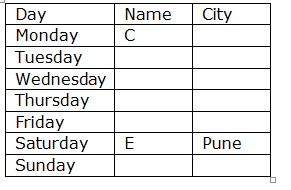 The one who goes on Tuesday is going to Punjab. G is going on Sunday. The one who is going on Thursday is going to Bangalore.
The one who goes on Tuesday is going to Punjab. G is going on Sunday. The one who is going on Thursday is going to Bangalore. 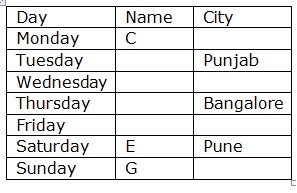 B going to Delhi but does not go on Friday. D goes to Dehradun. Hence, B have only option to go on Wednesday and D has also only one option to go on Friday.
B going to Delhi but does not go on Friday. D goes to Dehradun. Hence, B have only option to go on Wednesday and D has also only one option to go on Friday. 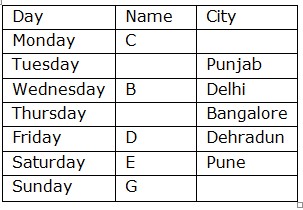 A does not go to Punjab. Hence, A has only one option to go on Thursday. Now we have only one employee is left who is F. So, place F in the table.
A does not go to Punjab. Hence, A has only one option to go on Thursday. Now we have only one employee is left who is F. So, place F in the table. 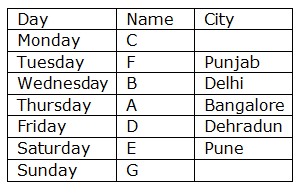 Now, C does not go to Mumbai because of this C has only one option to go to Meerut. Now, G goes to Mumbai.
Now, C does not go to Mumbai because of this C has only one option to go to Meerut. Now, G goes to Mumbai. 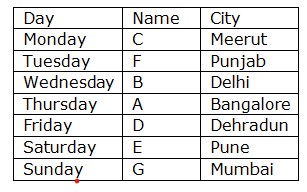
A train takes 30 minutes to travel 20 km, but due to maintenance, its speed is reduced by 25% for the next 10 km. Find the total time taken by the train...
A man travelled a total distance of 250 km. He travelled first 100 km on car with a speed of 20 km/h and rest of the distance on bike whose speed is 10 ...
Driving at 3/5 of my original speed I am 4 hours late for my office. What is my original time taken (km/h)?
In a 1500 m race, Anil beats Bakul by 150 m and in the same race Bakul beats Charles by 75 m. By what distance does Anil beat Charles?
The ratio of the speeds of two trains is 5:6. If each train increases its speed by 10 km/hrs., the ratio becomes 6:7. What is the original speed of the ...
Ravi travels the first 40% of a certain distance at a speed of 20 km/h, the next 30% at 10 km/h, and covers the remaining 30% at 12 km/h. Calculate Ravi...
- A car travels from city ‘A’ to city ‘B’ covering (1/3)rd of the total distance in 5 hours and the rest in 7 hours. If it takes 8 hours to return to...
‘A’ and ‘B’ started moving towards each other at same time with a speed of 25 km/hr and 20 km/hr, respectively. If the di...
Peter, John and Mike run around a Circular track starting from the same point simultaneously and in the same direction at the speed of 36 kmph, 54 kmph ...
A man travels some distance at a speed of 20 km/hr and returns at a speed of 15 km/hr. If the total time taken by him is 3 hrs 30 min, the distance is <...


